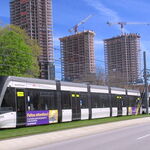I would assume that any sleeper car operating as part of a DMU consist would not be a DMU but simply a sleeper car linked in.
You are forgetting the dinning car. Eating in your seat is fine for short trips that happen to cross a single meal but people won't want to do so for breakfast, lunch and dinner. Some (but not all) DMUs have the power to tow an extra coach, but AFAIK, they can't tow 2 or more coaches. Then there is the potential for seasonal demand for multiple sleepers. All this begs the question, what is the benefit of using a DMU?
That said, I think DMUs would really only come in to play on the Senneterre, Jonquiere and White River trains, where only 2-3 pax (DMU) cars and a (unpowered) baggage car may be needed.
So you are looking at 3 routes. VIA would end up needing to buy almost as many spares trains as active units. At that cost they might as well buy a couple extra Siemens trainsets which they will already have spares available.
And those could have commonality with DMUs used out of the Kingston hub after HFR, where using Chargers may prove to be overkill.
Between Kingston and Toronto I suspect demand will be high enough that a conventional train will be more appropriate. While east of Kingston, demand could be low enough that a DMU might work (though in peak ridership periods, demand might still be high enough to make DMUs less efficient), there are reasons not to.
First of all, similar to the Sarnia situation, it would be preferable for some trains to continue past Kingston to avoid the need for a transfer when traveling between either Ottawa or Montreal and the Lakeshore. Yes the first train(s) in the morning will originate in Kingston and the last train(s) of the day will end there, but most trains will continue on to/from Ottawa or Montreal. The difference from today is that the schedule will be optimized for the Lakeshore, not travel between Toronto and Ottawa or Montreal.
Secondly, even if all trains did start/end in Kingston, trains to either Ottawa or Montreal would likely only be every 2-3 hours. That is about the same as the travel time, so VIA would only need about 4 or 5 extra trains for that service. Even when combined with the trains used in Northern Ontario and Quebec, that still isn't very many trains, and it would be cheaper and easier just to order extra trains from Siemens.
Depends what we're talking about. In a scenario where HFR is extended to London, it absolutely make sense to have a transfer at London. Probably on to a coach bus that is timed to meet those trains. Or if demand warranted it, a 2-car DMU that runs hourly to/from Sarnia.
If demand warranted hourly DMUs to/from Sarnia (which I highly doubt considering there is currently only 1 train a day) why not extend HFR to there?





/https://www.therecord.com/content/dam/therecord/news/waterloo-region/2016/03/04/via-rail-calls-on-old-trains-for-new-service-to-kitchener/B822388087Z.1_20160304173406_000_GDU1L089D.2_Gallery.jpg)